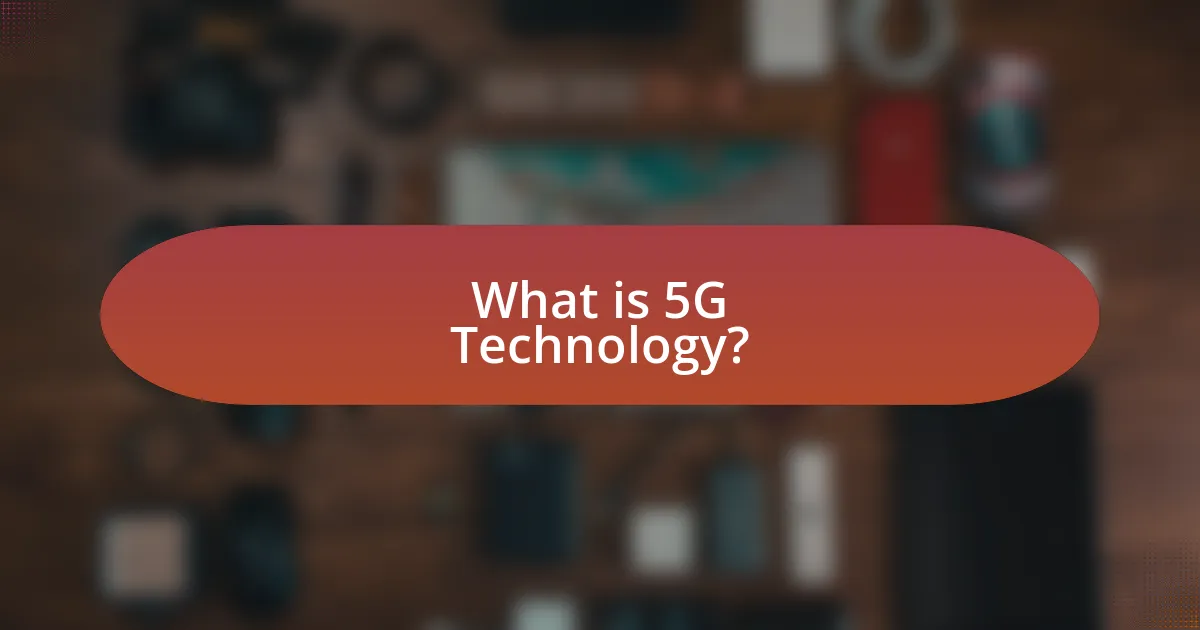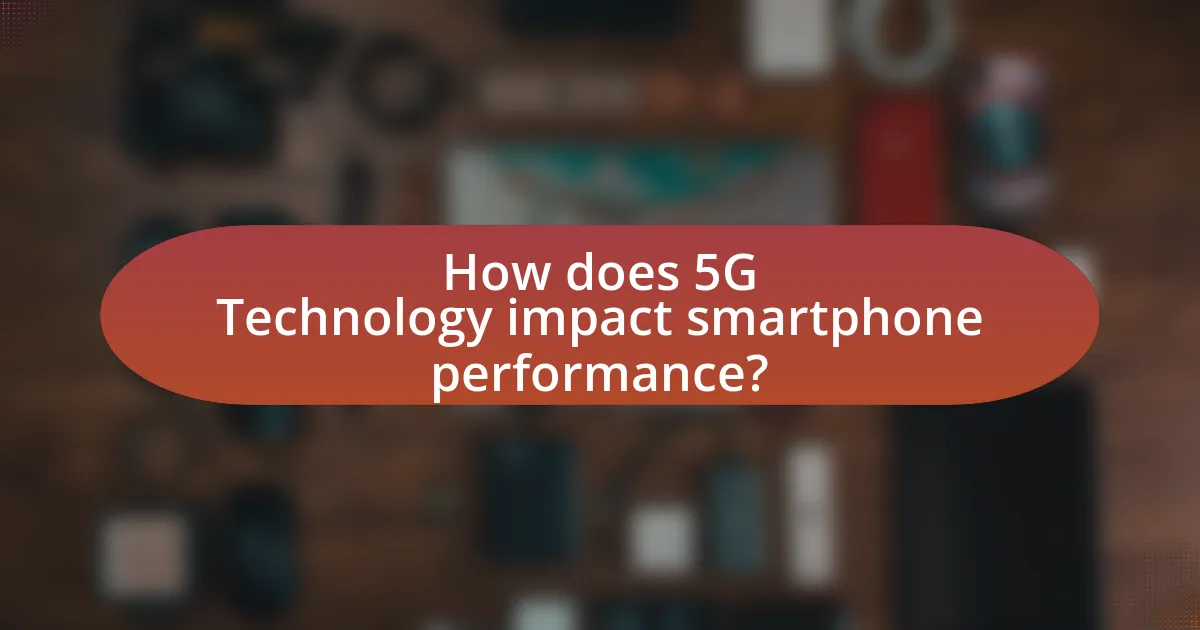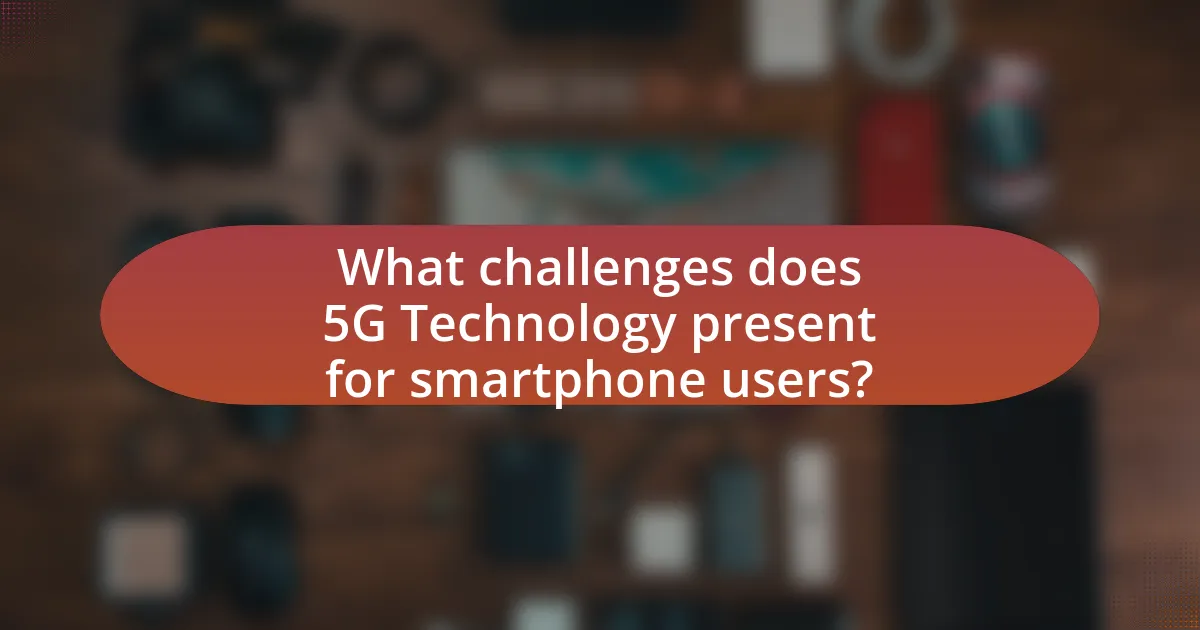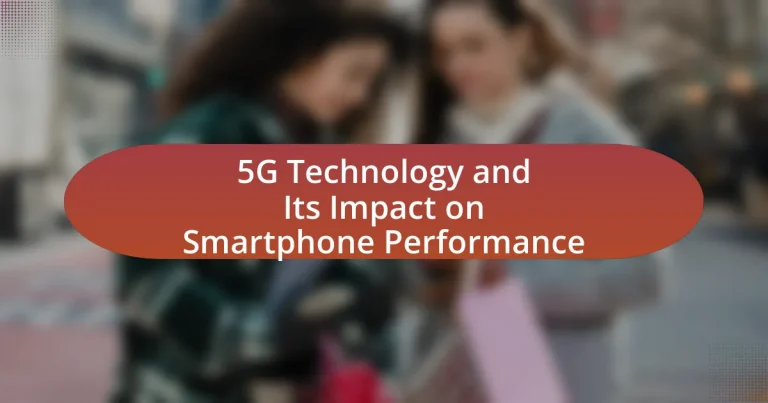5G technology represents the fifth generation of mobile network technology, offering significantly faster data speeds, lower latency, and enhanced connectivity compared to 4G. This article explores the key features of 5G, including its ability to support a higher number of simultaneous connections and its transformative potential across various sectors such as healthcare, transportation, and smart cities. Additionally, it examines the impact of 5G on smartphone performance, highlighting improvements in speed and latency, as well as challenges such as increased battery consumption and compatibility issues with existing devices. The discussion also addresses security concerns associated with 5G networks and provides best practices for optimizing smartphone performance in a 5G environment.

What is 5G Technology?
5G technology is the fifth generation of mobile network technology, designed to provide faster data speeds, lower latency, and greater connectivity compared to its predecessor, 4G. It operates on a range of frequencies, including sub-6 GHz and millimeter wave (mmWave), enabling it to support a higher number of devices simultaneously and facilitate advanced applications such as augmented reality and the Internet of Things (IoT). According to the International Telecommunication Union (ITU), 5G can achieve download speeds of up to 10 Gbps, significantly enhancing user experience in mobile communications.
How does 5G Technology differ from previous generations?
5G technology differs from previous generations primarily through its significantly higher data transfer speeds, lower latency, and increased capacity for connected devices. While 4G networks typically offer speeds up to 1 Gbps, 5G can achieve speeds exceeding 10 Gbps, enabling faster downloads and smoother streaming. Additionally, 5G reduces latency to as low as 1 millisecond compared to 30-50 milliseconds in 4G, which enhances real-time communication and responsiveness in applications like gaming and virtual reality. Furthermore, 5G supports a greater number of simultaneous connections, allowing for up to 1 million devices per square kilometer, compared to 4G’s limit of around 100,000 devices, which is crucial for the growing Internet of Things ecosystem.
What are the key features of 5G Technology?
The key features of 5G technology include enhanced data speeds, reduced latency, increased capacity, and improved connectivity. Enhanced data speeds can reach up to 10 Gbps, significantly faster than 4G, allowing for quicker downloads and smoother streaming. Reduced latency, which can be as low as 1 millisecond, enables real-time communication, essential for applications like autonomous driving and remote surgery. Increased capacity allows 5G networks to support a higher number of devices simultaneously, addressing the growing demand for connectivity in urban areas. Improved connectivity ensures more reliable connections in crowded environments, enhancing user experience. These features collectively contribute to the transformative potential of 5G technology in various sectors, including telecommunications, healthcare, and smart cities.
How does 5G Technology enhance connectivity?
5G technology enhances connectivity by providing significantly higher data transfer speeds, reduced latency, and increased capacity for simultaneous connections. This advancement allows for seamless streaming, faster downloads, and improved performance for applications requiring real-time data exchange. For instance, 5G networks can achieve speeds up to 10 Gbps, which is up to 100 times faster than 4G, enabling users to download large files in seconds. Additionally, 5G reduces latency to as low as 1 millisecond, facilitating instantaneous communication between devices, which is crucial for applications like autonomous vehicles and remote surgeries. The increased capacity of 5G networks supports a greater number of devices connected simultaneously, making it ideal for densely populated areas and the growing Internet of Things ecosystem.
What are the potential applications of 5G Technology?
5G technology has potential applications across various sectors, including enhanced mobile broadband, Internet of Things (IoT) connectivity, autonomous vehicles, smart cities, and telemedicine. Enhanced mobile broadband allows for faster data speeds and improved user experiences in streaming and gaming. IoT connectivity enables a vast number of devices to communicate seamlessly, facilitating smart home technologies and industrial automation. Autonomous vehicles rely on 5G for real-time data exchange, improving safety and navigation. Smart cities utilize 5G for efficient resource management and infrastructure monitoring. Telemedicine benefits from 5G through high-quality video consultations and remote patient monitoring, enhancing healthcare delivery. These applications demonstrate 5G’s transformative potential across multiple industries.
How can 5G Technology impact industries beyond smartphones?
5G technology can significantly impact industries beyond smartphones by enabling faster data transfer, lower latency, and increased connectivity for various applications. For instance, in healthcare, 5G facilitates remote surgeries and telemedicine by providing real-time data transmission, which is crucial for patient monitoring and diagnostics. In manufacturing, 5G supports the implementation of smart factories through enhanced IoT connectivity, allowing for real-time monitoring and automation of production processes. Additionally, in the transportation sector, 5G enhances vehicle-to-everything (V2X) communication, improving traffic management and enabling autonomous vehicles. These advancements are supported by studies indicating that 5G can achieve speeds up to 100 times faster than 4G, with latency as low as 1 millisecond, thus transforming operational capabilities across multiple industries.
What role does 5G play in the Internet of Things (IoT)?
5G plays a crucial role in the Internet of Things (IoT) by providing enhanced connectivity, higher data transfer speeds, and lower latency, which are essential for the efficient operation of IoT devices. The technology supports a massive number of connected devices simultaneously, enabling real-time data exchange and communication. For instance, 5G can support up to one million devices per square kilometer, significantly surpassing the capabilities of previous generations like 4G. This increased capacity allows for the deployment of smart cities, autonomous vehicles, and advanced industrial automation, all of which rely on seamless connectivity and rapid data processing to function effectively.

How does 5G Technology impact smartphone performance?
5G technology significantly enhances smartphone performance by providing faster data speeds, lower latency, and improved connectivity. With data transfer rates potentially exceeding 10 Gbps, smartphones can download large files, stream high-definition content, and engage in real-time applications more efficiently. Additionally, the reduced latency, often below 10 milliseconds, allows for quicker response times in applications such as gaming and video conferencing. This performance boost is supported by the deployment of advanced network infrastructure, including small cells and beamforming technology, which optimize signal strength and reliability.
What improvements in speed and latency can users expect?
Users can expect significant improvements in speed and latency with 5G technology, achieving download speeds up to 10 Gbps and latency as low as 1 millisecond. This enhancement is primarily due to the advanced radio technology and increased bandwidth that 5G networks utilize, allowing for faster data transmission and reduced delays in communication. For instance, 5G can support up to 1 million devices per square kilometer, which facilitates seamless connectivity and enhances user experience in high-density areas.
How does increased speed affect app performance on smartphones?
Increased speed significantly enhances app performance on smartphones by reducing latency and improving data transfer rates. This allows applications to load faster, stream content with minimal buffering, and provide real-time updates more efficiently. For instance, 5G technology can achieve download speeds up to 10 Gbps, which is substantially higher than 4G, enabling applications that require high bandwidth, such as video conferencing and online gaming, to function seamlessly. Studies have shown that users experience a 50% reduction in loading times for apps when utilizing 5G compared to 4G networks, demonstrating the direct correlation between increased speed and improved app performance.
What is the significance of reduced latency for mobile gaming?
Reduced latency is crucial for mobile gaming as it enhances real-time responsiveness, allowing players to react instantly to in-game actions. This improvement leads to a more immersive and competitive gaming experience, where even milliseconds can determine the outcome of a match. For instance, 5G technology significantly reduces latency to as low as 1 millisecond compared to 4G’s average of 30-50 milliseconds, enabling smoother gameplay and reducing lag. This reduction in latency is essential for fast-paced games, where quick reflexes are vital for success.
How does 5G Technology influence battery life and efficiency?
5G technology generally decreases battery life and efficiency due to its higher energy demands compared to previous generations. The increased data transmission speeds and lower latency require more power, especially when devices frequently switch between 5G and 4G networks. Research indicates that 5G can consume up to 100 times more energy than 4G during peak usage, leading to faster battery depletion. Additionally, the use of advanced technologies like Massive MIMO and beamforming in 5G networks can further strain battery resources, as devices must maintain connections with multiple antennas.
What are the energy consumption differences between 4G and 5G smartphones?
5G smartphones generally consume more energy than 4G smartphones due to the increased complexity of 5G technology and its higher data transmission rates. Research indicates that while 5G can be more efficient in terms of data per watt, the overall energy consumption can be higher because 5G networks require more base stations and advanced hardware to support their capabilities. For instance, a study by the International Telecommunication Union found that 5G networks could lead to a 90% increase in energy consumption compared to 4G networks under certain conditions, particularly in dense urban areas where the demand for high-speed data is greatest.
How can manufacturers optimize battery life for 5G devices?
Manufacturers can optimize battery life for 5G devices by implementing advanced power management techniques and optimizing hardware components. These techniques include using energy-efficient chipsets designed specifically for 5G, which can reduce power consumption during data transmission. For instance, Qualcomm’s Snapdragon 888 features integrated 5G capabilities that enhance energy efficiency compared to previous generations. Additionally, manufacturers can utilize software optimizations, such as adaptive power-saving modes that adjust performance based on usage patterns, thereby extending battery life. Research indicates that optimizing network protocols and reducing idle power consumption can further enhance battery longevity in 5G devices.

What challenges does 5G Technology present for smartphone users?
5G technology presents several challenges for smartphone users, primarily including increased battery consumption, limited coverage, and potential compatibility issues. Increased battery consumption occurs because 5G requires more power to maintain connections, especially in areas with weak signals, leading to faster battery drain. Limited coverage is another challenge, as 5G networks are still being rolled out, resulting in inconsistent access in many regions. Additionally, not all smartphones are compatible with 5G technology, which can lead to confusion and frustration for users who may need to upgrade their devices to take advantage of the new network.
What are the compatibility issues with existing devices?
Compatibility issues with existing devices primarily stem from hardware limitations and software incompatibility with 5G networks. Many older smartphones lack the necessary 5G modem and antenna configurations required to connect to 5G networks, which can result in reduced performance or complete inability to access 5G services. For instance, devices designed for 4G LTE may not support the higher frequency bands utilized by 5G, leading to connectivity problems. Additionally, software updates may be required for existing devices to optimize performance on new 5G networks, but not all manufacturers provide these updates for older models, further complicating compatibility.
How can users determine if their smartphone is 5G compatible?
Users can determine if their smartphone is 5G compatible by checking the device specifications provided by the manufacturer. Most manufacturers list 5G compatibility in the technical specifications section on their official websites or in the user manual. Additionally, users can look for the 5G logo on the device packaging or within the smartphone settings under network options, where 5G connectivity should be explicitly mentioned if supported. According to a report from the GSMA, as of 2023, over 1 billion 5G devices have been shipped globally, indicating a significant market presence for 5G-capable smartphones.
What are the implications of transitioning to 5G for older devices?
Transitioning to 5G has significant implications for older devices, primarily resulting in reduced compatibility and performance limitations. Older devices, typically designed for 4G or earlier networks, may not support the new 5G frequency bands or technologies, leading to a lack of access to 5G networks. According to a report by the GSMA, as of 2023, approximately 30% of mobile devices in use globally are incompatible with 5G, which means users of these devices will not benefit from the enhanced speeds and lower latency that 5G offers. Additionally, even if older devices can connect to 5G networks, they may experience slower speeds and increased latency compared to newer models specifically designed for 5G, as they lack the necessary hardware and software optimizations.
What security concerns are associated with 5G Technology?
5G technology presents several security concerns, primarily due to its increased complexity and reliance on software. The expanded attack surface, resulting from the integration of various devices and services, makes networks more vulnerable to cyberattacks. For instance, the use of network slicing can lead to unauthorized access if not properly secured, allowing attackers to exploit vulnerabilities in one slice to affect others. Additionally, the reliance on third-party vendors for infrastructure components raises risks related to supply chain security, as seen in incidents involving compromised hardware or software. Furthermore, the potential for increased data interception during transmission poses privacy risks, as 5G networks support higher data rates and more connected devices, amplifying the volume of sensitive information transmitted.
How does 5G Technology change the landscape of mobile security?
5G technology significantly enhances mobile security by introducing advanced encryption methods and improved authentication protocols. The increased bandwidth and lower latency of 5G networks allow for more robust security measures, such as real-time threat detection and response capabilities. For instance, 5G networks utilize network slicing, which isolates different types of data traffic, thereby reducing the risk of unauthorized access and data breaches. Additionally, the integration of edge computing in 5G allows for localized data processing, minimizing the amount of sensitive information transmitted over the network. This shift not only strengthens data privacy but also aligns with the growing demand for secure mobile communications in an increasingly connected world.
What measures can users take to protect their data on 5G networks?
Users can protect their data on 5G networks by employing strong encryption methods, utilizing virtual private networks (VPNs), and regularly updating their devices. Strong encryption ensures that data transmitted over the network is secure from unauthorized access. VPNs create a secure tunnel for data, making it difficult for hackers to intercept information. Regular updates to devices help patch vulnerabilities that could be exploited on 5G networks, as evidenced by cybersecurity reports indicating that outdated software is a common entry point for attacks.
What are the best practices for maximizing smartphone performance on 5G?
To maximize smartphone performance on 5G, users should ensure their device is updated with the latest software and firmware. Regular updates optimize system performance and security, which is crucial for handling the high speeds and low latency of 5G networks. Additionally, users should manage background applications to reduce resource consumption, as excessive apps running simultaneously can hinder performance.
Using a 5G-compatible device is essential, as older models may not fully utilize the capabilities of 5G networks. Furthermore, connecting to the optimal 5G band, whether low, mid, or high frequency, can enhance speed and reliability. Users should also consider disabling unnecessary features like location services and Bluetooth when not in use, as these can drain battery life and processing power.
Finally, utilizing network management tools can help monitor data usage and optimize settings for better performance. These practices collectively ensure that smartphones operate efficiently on 5G networks, leveraging the technology’s full potential.
How can users optimize their settings for better 5G performance?
Users can optimize their settings for better 5G performance by ensuring their device is set to use 5G networks preferentially. This can be achieved by navigating to the network settings on their smartphone and selecting the option for 5G or “5G preferred” mode, which allows the device to connect to 5G networks whenever available. Additionally, users should keep their device’s software updated, as manufacturers often release updates that enhance network performance and compatibility with 5G technology. Research indicates that devices configured to prioritize 5G connections can experience significantly improved download and upload speeds, with some studies showing speed increases of up to 100% compared to 4G connections under optimal conditions.
What tips can enhance the overall user experience with 5G smartphones?
To enhance the overall user experience with 5G smartphones, users should ensure they are in areas with strong 5G coverage, as this significantly improves connectivity and speeds. Utilizing 5G networks can reduce latency and increase download speeds, allowing for smoother streaming and faster downloads. Additionally, keeping the smartphone’s software updated optimizes performance and security, which is crucial for leveraging the full capabilities of 5G technology. Using compatible accessories, such as 5G-enabled routers and devices, can further enhance connectivity and performance. According to a report by the GSMA, 5G networks can deliver speeds up to 100 times faster than 4G, demonstrating the importance of utilizing the technology effectively for an improved user experience.




